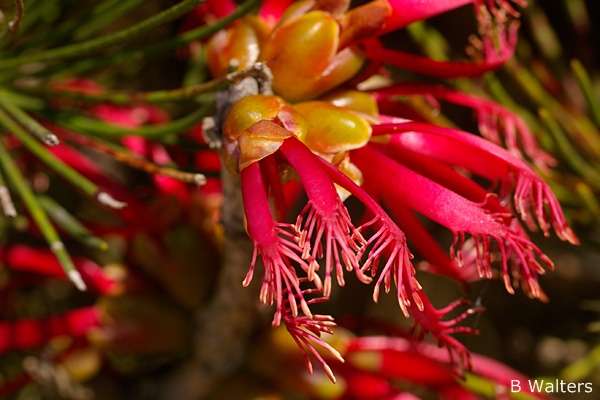General Description:
Calothamnus is a genus of more than 40 species, all of which are found in south Western Australia. It is related to Melaleuca but differs in the arrangement of the anthers on the ends of the stamens. Its closest relatives are other Western Australian genera including Beaufortia, Eremaea and Regelia. All members of the genus have red or reddish flowers; some also have yellow or brown flowers. Most have linear to needle shaped leaves; a few have slightly broader leaves.
The genus was named by Jacques Labillardiere in 1806 when he published the description for C.sanguineus.
Several members of the genus are called “claw-flowers” because of the claw-like shape of the stamen bundles. The name ‘net bush’ is also used for some species because the long stamens on the one-sided flower clusters resemble a net but this name is not officially recognized. C.graniticus has no official common name so we have dubbed it granite claw flower.
Two sub-species of C.graniticus are recognised: the type (subspecies graniticus) and a narrow leafed sub-species leptophyllus (Greek leptos, thin; phyllon, leaf). Both are small to medium shrubs with bright red (occasionally cream) flowers which appear in late autumn to winter. The flowers contain nectar and are attractive to honey-eating birds. The curvature of the flower nicely matches that of the bird’s beak so the pollen is deposited on the birds head. Flowers are followed by large woody seed capsules which retain the seed for many years. C.graniticus develops a lignotuber and can regenerate from this after a fire.
C.graniticus is an attractive shrub well suited to a sunny position in areas with a Mediterranean climate. It can become rather woody with age especially when carrying many seed capsules, but it responds to hard pruning and will tolerate extended dry periods once established. The suitability of the species for more humid climates is not known but Calothamnus, generally, seem more adaptable to such areas than many other species from the south-west.
Propagation is easy from seed and presumably from cuttings.

Calothamnus graniticus subsp. graniticus
Photo: Brian Walters
 Australian Native Plants Society (Australia)
Australian Native Plants Society (Australia)













